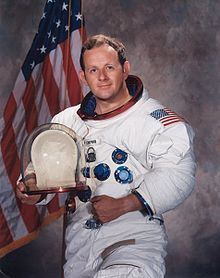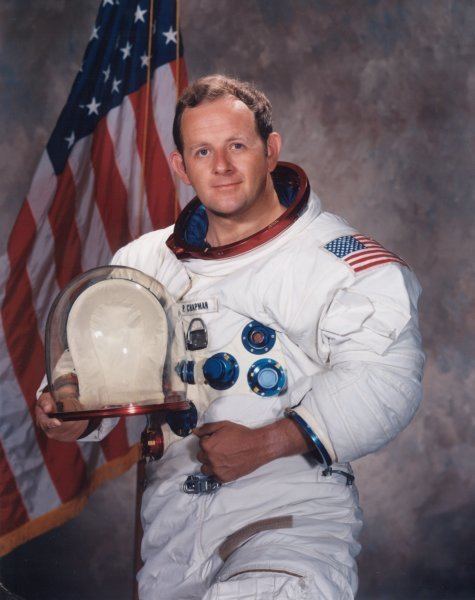Nationality Australia-American Missions None Other occupation Engineer Selection 1967 | Time in space 0 Role Astronaut Status Retired Name Philip Chapman | |
 | ||
Books "Eva": A Remarkable Mother-in-law ; Oral Reminiscences of a Norfolk Lady | ||
Bette Rogge interviews Philip K. Chapman
Philip Kenyon Chapman (born 5 March 1935) was the first Australian-born American astronaut, serving for about five years in NASA Astronaut Group 6 (1967).
Contents
- Bette Rogge interviews Philip K Chapman
- Education
- Work
- Views on global warming
- Honorary positions
- Biography
- References

Education
Born in Melbourne, Australia, his family moved to Sydney and after attending the Fort Street Opportunity School, he attended Parramatta High School. He went on to attend the University of Sydney, earning a B.S.) in physics and mathematics in 1956. He then attended the Massachusetts Institute of Technology in the United States, earning a M.S. in aeronautics and astronautics in 1964 and a Sc.D. in instrumentation in 1967.
Work
Chapman served with the Royal Australian Air Force Reserve from 1953 to 1955. He learned to fly (in a Tiger Moth) during Australian National Service.
From 1956 to 1957, he worked for Philips Electronics Industries Proprietary Limited in Sydney, Australia. He then spent 15 months in Antarctica with the Australian National Antarctic Research Expeditions (ANARE), for the International Geophysical Year (IGY) as an auroral/radio physicist. The work required that he spend most of the winter with one other man at a remote camp.
From 1960 to 1961, he was an electro-optics staff engineer in flight simulators for Canadian Aviation Electronics Limited in Dorval, Quebec. His next assignment was as a staff physicist at the Massachusetts Institute of Technology, where he worked in electro-optics, inertial systems, and gravitational theory until the summer of 1967.
After gaining U.S. citizenship, Chapman was selected as a scientist-astronaut by NASA in August 1967. He trained as an astronaut, including jet pilot training with the USAF, and served as the Apollo 14 Mission Scientist. He resigned from the program near the close of the Apollo Program in July 1972, largely because he strongly disagreed with the decision to build the Space Shuttle.
After spending the next five years working on laser propulsion at Avco Everett Research Laboratory, he moved to Arthur D. Little to work with Dr. Peter Glaser, the inventor of the solar power satellite (SPS). Dr. Chapman was actively involved in the NASA/DOE SPS Concept Development and Evaluation Program (CDEP) in the late 1970s and early 1980s and has since continued contributions to the literature on power from space.
In the mid-80s, Dr. Chapman shifted his focus to commercial space—building private companies that develop products and services for space-based, as well as Earth-oriented businesses. He served as president of the L5 Society (now the National Space Society) during the successful campaign to stop the US Senate from ratifying the Moon Treaty, which would have excluded any commercial activity on the Moon.
Dr. Chapman is a member of the Citizens' Advisory Council on National Space Policy, which has advised several US Presidents on space-related issues. In particular, a position paper by the Council was instrumental in convincing Ronald Reagan that it was technically feasible to intercept ballistic missiles in flight. Opponents thought the Strategic Defense Initiative (SDI) was a fantasy, dubbing it "Star Wars".
In 1989, Dr. Chapman led a privately funded scientific expedition by sea from Cape Town to Enderby Land, Antarctica, to gather information about mineral resources before the Madrid Protocol to the Antarctic Treaty made prospecting illegal on the continent.
From 1989-1994, Dr. Chapman was the president of Echo Canyon Software in Boston, which produced the first visual programming environment for Windows, before Microsoft introduced Visual Basic.
In 1998, Dr. Chapman was Chief Scientist of Rotary Rocket of San Mateo, California. Rotary Rocket built and flew atmospheric tests of the Roton, a novel manned, re-usable space launch vehicle.
In 2004, Dr. Chapman presented two papers at the 55th International Astronautical Congress (Vancouver CANADA). The first, "Luces in the Sky with Diamonds," presented a design for a gossamer, iso-inertial SPS using thin films of artificial diamond in thermionic conversion devices. The second paper, "Power from Space and the Hydrogen Economy," discussed the implications of the recent discovery of vast deposits of methane hydrates under Arctic permafrost and on continental shelves, which may be sufficient to meet all world energy needs for many thousands of years. See the web address below for full text of this paper.
Dr. Chapman was Chief Scientist of Transformational Space Corporation, "t/Space" of Reston, VA. Under a $6 million contract from NASA, t/Space has developed a plan and re-usable vehicle to support the International Space Station (ISS), after the shuttles retire in 2010. The Roton is a manned spacecraft that is owned and operated by private enterprise. NASA has now adopted commercial support as its baseline plan for the ISS.
In 2009, Dr. Chapman formed the Solar High Study Group, "a team of senior managers and technologists with directly relevant experience who believe that space-based solar power can solve the problem of bringing clean, affordable energy to people anywhere on Earth or in space." In July 2010, Dr. Chapman presented slides to the US Air Force on the topic of Tactical and Strategic Implications of Space Based Solar Power (SBSP). Main conclusions include the US is able to deploy SBSP within 7 years with technologies now at Technology Readiness Level 6+ and that a study of national security implications of SBSP is urgently needed. Information from this event will contribute to a USAF policy paper on its energy strategy.
Views on global warming
On 23 April 2008, Dr Chapman authored an op-ed in The Australian newspaper, noting a new ice age will eventually occur, that based on current low solar activity it might even be imminent, and "It is time to put aside the global warming dogma, at least to begin contingency planning about what to do if we are moving into another little ice age, similar to the one that lasted from 1100 to 1850.". A response by IPCC affiliated meteorologist Dr. David Karoly was published a few days later.
Dr. Chapman writes a blog (www.pkchapman.com) that has several posts with lots of data about climate change and other topics that interest him.
Honorary positions
Biography
Chapman's career is chronicled in the book "NASA's Scientist-Astronauts" by David Shayler and Colin Burgess.
Chapman's NASA years are also described in Australia's Astronauts: Three Men and a Spaceflight Dream, 1999, by Colin Burgess.
